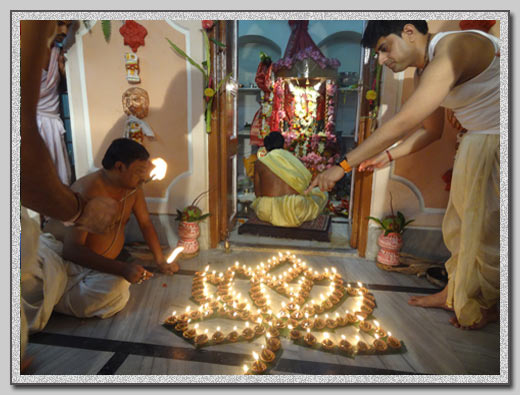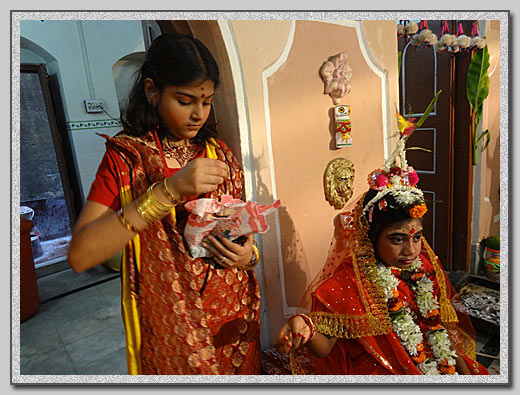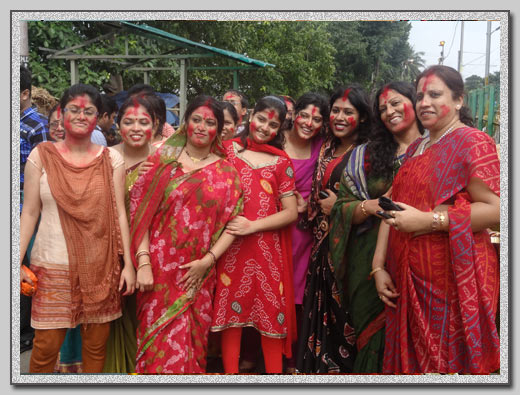
Maha Sasthi
The Rituals of Bodhan is usually done on Panchami. In the evening , the rituals of Amantran and Adhibas of the Goddess is being performed. The Dhakis arrives on Panchami itself. On this day the women folk of the house do not observe fasting or eat vegeterian food. They have fish meal and greet the Goddess with the ritual of Baran chewing beetle leaves.
Maha Saptami
 The Nabapatrika Rituals aka Kalabou Snan starts early in the morning. The other branch of Haldar family of Baghbazar also celebrates Durga Puja. Therfore the procession of taking Nabapatrika towards Mayer Ghat is carried on with two giant embroidered umbrellas , one each of the two Haldar family. This is one of the speciality of Nabapatrika rituals of Haldar Family.
The Nabapatrika Rituals aka Kalabou Snan starts early in the morning. The other branch of Haldar family of Baghbazar also celebrates Durga Puja. Therfore the procession of taking Nabapatrika towards Mayer Ghat is carried on with two giant embroidered umbrellas , one each of the two Haldar family. This is one of the speciality of Nabapatrika rituals of Haldar Family.
The Nabapatrika is a combination of nine plants namely banana, colacassia, turmeric, jayanti, wood apple, pomegranate, aurum, rice, and ashoka. They are tied together with twigs of Aparajita a long with nine bunches of yellow thread. Each of the nine plants represents one form of Durga. It must be mentioned here that the Goddess Durga was actually a Goddess for the crops and it was not till in 8th century she attained the Mashishur Mardini Image.
After the Kalabou Snan, the household members return back to the Haldar rseidence, where the Nabapatika is wrapped up in a saree and placed besides the Durag Idol. Many devotees visit the Haldar residence on that date.
Maha Astami
 This is the most important day of Durgapuja. In the morning members of the Haldar residence of Baghbazar pay their homage to the Goddess by offering Pushpanajali. Many family members , relatives and friends offer their homage in unison to the Goddess.
This is the most important day of Durgapuja. In the morning members of the Haldar residence of Baghbazar pay their homage to the Goddess by offering Pushpanajali. Many family members , relatives and friends offer their homage in unison to the Goddess.
The all important worship at conjunction alias Sandhipuja rituals starts in the evening . The ritual is named so as it takes place during the conjunction (Sandhikhan)of day of Astami and the day of Nabami. To be precise , the Sandhipuja rituals takes place during the last twenty four minutes of Astami and first twenty four minutes of Nabami. It is at this time, a frightening female form named emerged from the third eye of the Goddess. This figure beheaded with a chopper the two generals of demon Mahishasur-Chanda and Munda. Sandhipuja is the time of that battle. The Goddess is worshipped in this period as Chamunda - the frightening female form having blood dripping from the tongue.
The essential ingridients of the Sandhipuja rituals include one hundred and eight lotus, equal number of lamps, uncut fruits, flower garlands, clothes and ornaments. At Haldar residence, the speciality of Sandhipuja is the arrangment of the lamps. Sometimes it is like a conch , sometimes it is like lotus and many other patterns. Ecah year's arrangment is in accordance with the divine intervention received from the Goddess.
Maha Nabami
 The most important ritual on Mahanabami is Kumari Puja (worship of a virgin). In many household Kumari Puja is performed on Astami, but in the Haldar residence it is performed in the morning hours of Nabami after the rituals of Aarti and Hom. Kumari Puja involves the worship of a virgin girl. The age of Kumari girl has to be between one to sixteen, should be unmarried, not involved in worldly affairs and not into her menstrual cycle. The girl is worshipped in separate form depending on her age. For exmaple, a girl of thirteen is worshipped as Mahalaksmi, whereas a girl of sixteen is worshipped as Ambika.
The most important ritual on Mahanabami is Kumari Puja (worship of a virgin). In many household Kumari Puja is performed on Astami, but in the Haldar residence it is performed in the morning hours of Nabami after the rituals of Aarti and Hom. Kumari Puja involves the worship of a virgin girl. The age of Kumari girl has to be between one to sixteen, should be unmarried, not involved in worldly affairs and not into her menstrual cycle. The girl is worshipped in separate form depending on her age. For exmaple, a girl of thirteen is worshipped as Mahalaksmi, whereas a girl of sixteen is worshipped as Ambika.
At Haldar residence of Baghbazar, the Kumari is selected after minutely considering several factors. Devi Purana recommends a Brhamin Girl, but this changes with the purpose of the Puja. For devotees performing Kumari Puja for acheiving a boon of victory worships a Kshatriya girl, a Vaishya girl is worshipped for the purpose of gaining profits in business.
During the Kumari Puja
, the chosen girl is bathed with holy water and dressed in a new saree. She is dressed up with flowers and jewelleries. Her feet is smeared with Aalta. She fasts from morning until the Puja is over. She is worshipped as the Goddess while she holds a flower tken from the hand of the deity.
 Dashami
Dashami
On Dashami, unlike other household the members of Haldar family is not upest. This is because our idol is a perament deity and it is not immersed in the Ganges. The only ritual of Biswarjan performed here that of changing the water in the Ghot (pitcher) of the Goddess in the river. The women folk accompanies with the priest to the river and plays with vermillion (Sindur Khela). In the evening the Priest sparkles holy water on everyone's forehead for peace ( Shantir Jol).
After having sweets, members write "Shree Shree Durga" three times. The position of the idol is then changed from facing South to facing West for daily worship.


 The Nabapatrika Rituals aka Kalabou Snan starts early in the morning. The other branch of Haldar family of Baghbazar also celebrates Durga Puja. Therfore the procession of taking Nabapatrika towards Mayer Ghat is carried on with two giant embroidered umbrellas , one each of the two Haldar family. This is one of the speciality of Nabapatrika rituals of Haldar Family.
The Nabapatrika Rituals aka Kalabou Snan starts early in the morning. The other branch of Haldar family of Baghbazar also celebrates Durga Puja. Therfore the procession of taking Nabapatrika towards Mayer Ghat is carried on with two giant embroidered umbrellas , one each of the two Haldar family. This is one of the speciality of Nabapatrika rituals of Haldar Family. This is the most important day of Durgapuja. In the morning members of the Haldar residence of Baghbazar pay their homage to the Goddess by offering Pushpanajali. Many family members , relatives and friends offer their homage in unison to the Goddess.
This is the most important day of Durgapuja. In the morning members of the Haldar residence of Baghbazar pay their homage to the Goddess by offering Pushpanajali. Many family members , relatives and friends offer their homage in unison to the Goddess.  The most important ritual on Mahanabami is Kumari Puja (worship of a virgin). In many household Kumari Puja is performed on Astami, but in the Haldar residence it is performed in the morning hours of Nabami after the rituals of Aarti and Hom. Kumari Puja involves the worship of a virgin girl. The age of Kumari girl has to be between one to sixteen, should be unmarried, not involved in worldly affairs and not into her menstrual cycle. The girl is worshipped in separate form depending on her age. For exmaple, a girl of thirteen is worshipped as Mahalaksmi, whereas a girl of sixteen is worshipped as Ambika.
The most important ritual on Mahanabami is Kumari Puja (worship of a virgin). In many household Kumari Puja is performed on Astami, but in the Haldar residence it is performed in the morning hours of Nabami after the rituals of Aarti and Hom. Kumari Puja involves the worship of a virgin girl. The age of Kumari girl has to be between one to sixteen, should be unmarried, not involved in worldly affairs and not into her menstrual cycle. The girl is worshipped in separate form depending on her age. For exmaple, a girl of thirteen is worshipped as Mahalaksmi, whereas a girl of sixteen is worshipped as Ambika. Dashami
Dashami